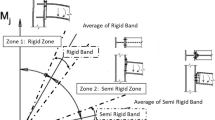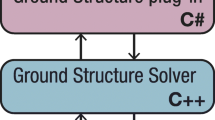Abstract
Society is building at an unprecedented rate: to house over 200,000 people moving to cities each day building stock will need to double by 2060. Importantly, the embodied carbon of construction due to material extraction, manufacturing, transportation, and demolition accounts for 11% of global carbon emissions, and this number is only expected to rise. With no end to construction in sight, it is essential that we develop better building practices. The research presented in this paper begins with the critical issue of embodied energy in horizontal structural systems. In high-rise buildings, between 60 and 80% of the mass and embodied energy of the structure can be found in the floors, suggesting a compelling starting point for materially efficient design. A reduction in a floor system’s mass can lead to a similar reduction in the mass of vertical (columns, walls) and lateral systems. This paper focuses on the design of horizontal spanning elements, such as floor beams and slabs, and has two parts. The first part evaluates and compares historic methods of shaped beam design and classical methods of structural optimization. The second part presents a new flexible method of beam shape optimization. These design methods for structural efficiency allow us to build far more with far less, reducing the environmental and economic costs of construction while meeting the demands of a growing population.

















Similar content being viewed by others
References
Detter D (2018) How cities can lead the way in bridging the global housing gap. World Economic Forum. https://www.weforum.org/agenda/2018/06/cities-global-housing-gap-dag-detter/. Accessed 19 Sept 2020
Abergel T, Dean B, Dulac J (2017) Global Status Report 2017: Towards a zero-emission, efficient, and resilient buildings and construction sector. U. N. Environ. Programme, p 48
De Wolf CEL (2017) Low carbon pathways for structural design: embodied life cycle impacts of building structures. Thesis, Massachusetts Institute of Technology. Accessed 27 Sept 2017. [Online]. http://dspace.mit.edu/handle/1721.1/111491
Foraboschi P, Mercanzin M, Trabucco D (2014) Sustainable structural design of tall buildings based on embodied energy. Energy Build 68(Part A):254–269. https://doi.org/10.1016/j.enbuild.2013.09.003
Anderson S (2004) Eladio Dieste: innovation in structural art, 1st edn. Princeton Architectural Press, New York
Raj M, Mehta V, Mehndiratta RR, Huber A (eds) (2016) The structure: works of Mahendra Raj. Park Books, Zurich
Bechthold M (2003) On shells and blobs—structural surfaces in the digital age. Harv Des Mag 19. [Online]. Available: https://www.researchgate.net/publication/297452900_On_shells_and_blobs_-_Structural_surfaces_in_the_digital_age. Accessed 14 Mar 2018
Timoshenko S (1953) History of strength of materials: with a brief account of the history of theory of elasticity and theory of structures. Dover Publications, New York
Timoshenko S (1930) Strength of materials. Krieger Pub. Co., Malabar
Muttoni A (2011) The art of structures: introduction to the functioning of structures in architecture. EPFL Press
Opatowski I (1945) Cantilever beams of uniform strength. Q Appl Math 3(1):76–81
Li JP , Gross WA (1955) Beams of uniform strength subjected to uniformly distributed load. Proceedings of the Iowa Academy of Science 62(1)
Barnett RL (1963) Minimum-weight design of beams for deflection. Trans Am Soc Civ Eng 128(1):221–255
Haftka RT, Gürdal Z, Kamat MP (1990) Elements of structural optimization. Springer Netherlands, Dordrecht. [Online]. Available: https://doi.org/10.1007/978-94-015-7862-2. Accessed 20 Nov 2018
Haug EJ Jr, Kirmser PG (1967) Minimum weight design of beams with inequality constraints on stress and deflection. J Appl Mech 34(4):999–1004. https://doi.org/10.1115/1.3607869
Dupuis G (1971) Optimal design of statically determinate beams subject to displacement and stress constraints. AIAA J 9(5):981–984
Heyman J (1959) On the absolute minimum weight design of framed structures. Q J Mech Appl Math 12(3):314–324. https://doi.org/10.1093/qjmam/12.3.314
Barnett RL (1966) Survey of optimum structural design. Exp Mech 6(12):19A-26A
Maki AC, Kuenzi EW (1965) Deflection and stressses of tapered wood beams. Forest Products Laboratory
Paglietti A, Carta G (2009) Remarks on the current theory of shear strength of variable depth beams. Open Civ Eng J 3(1):28–33
Mayencourt P, Mueller C (2020) Hybrid analytical and computational optimization methodology for structural shaping: material-efficient mass timber beams. Eng Struct 215:110532
Haftka RT, Grandhi RV (1986) Structural shape optimization—a survey. Comput Methods Appl Mech Eng 57(1):91–106
Imam MH (1982) Three-dimensional shape optimization. Int J Numer Methods Eng 18(5):661–673
Braibant V, Fleury C (1984) Shape optimal design using B-splines. Comput Methods Appl Mech Eng 44(3):247–267
Veenendaal D, Coenders J, Vambersky J, West M (2011) Design and optimization of fabric-formed beams and trusses: evolutionary algorithms and form-finding. Struct Concr 12(4):241–254
Orr JJ, Darby A, Ibell T, Evernden M (2014) Design methods for flexibly formed concrete beams. Proc Inst Civ Eng - Struct Build 167(11):654–666
Rechenraum e.U.—goat (2018). https://www.rechenraum.com/en/goat.html. Accessed 6 May 2018
Brown NC, Jusiega V, Mueller CT (2020) Implementing data-driven parametric building design with a flexible toolbox. Autom Constr 118:103252
Powell MJD (2007) A view of algorithms for optimization without derivatives. Cambridge University Technical Report DAMTP, p 12
Barnhill RE (1977) Representation and approximation of surfaces. In: Rice JR (ed) Mathematical software, Elsevier, pp 69–120. https://doi.org/10.1016/B978-0-12-587260-7.50008-X
Taylor JE (1969) Maximum strength elastic structural design. J Eng Mech Div 95(3):653–664
Makky SM, Ghalib MA (1979) Design for minimum deflection. Eng Optim 4(1):9–13
Ismail MA, Mueller CT (2019) A platform of design strategies for the optimization of concrete floor systems in India. In: Cruz PJS (ed) Structures and architecture: bridging the gap and crossing borders, 1st edn. CRC Press, pp 399–408. https://doi.org/10.1201/9781315229126-47
Buswell RA, Leal de Silva WR, Jones SZ, Dirrenberger J (2018) 3D printing using concrete extrusion: a roadmap for research. Cem Concr Res 112:37–49
Paolini A, Kollmannsberger S, Rank E (2019) Additive manufacturing in construction: a review on processes, applications, and digital planning methods. Addit Manuf 30:100894. https://doi.org/10.1016/j.addma.2019.100894
Huang Y, Garrett CR, Mueller CT (2018) Automated sequence and motion planning for robotic spatial extrusion of 3D trusses. Constr Robot. https://doi.org/10.1007/s41693-018-0012-z
Ismail MA, Mueller CT (2021) Minimizing embodied energy of reinforced concrete floor systems in developing countries through shape optimization. Eng Struct 246:112955. https://doi.org/10.1016/j.engstruct.2021.112955
ACI Committee 318, ACI Committee 318, ACI Committee 318, and American Concrete Institute (2016) Building code requirements for structural concrete (ACI 318-14): an ACI standard; Commentary on building code requirements for structural concrete (ACI 318R-14): an ACI report
Bureau of Indian Standards (2000) IS 456: Plain and reinforced concrete—code of practice
Hawkins WJ et al (2016) Flexible formwork technologies—a state of the art review. Struct Concr 17(6):911–935
Architecture 2030 (2018) New buildings: embodied carbon. https://architecture2030.org/new-buildings-embodied/. Accessed 30 Jun 2021
Block P, Paulson N (2019) E4: efficiency, economy, elegance, and ecology. In: Design—tales of science and innovation, Chronos Verlag, pp 13–21
Rozvany GIN (1976) Optimal design of flexural systems. Elsevier. https://doi.org/10.1016/C2013-0-02754-5
Acknowledgements
Funding for this research was provided by the Dar Group Urban Seed Grant Program at the Norman B. Leventhal Center for Advanced Urbanism, Massachusetts Institute of Technology.
Author information
Authors and Affiliations
Corresponding author
Additional information
Publisher’s Note
Springer Nature remains neutral with regard to jurisdictional claims in published maps and institutional affiliations.
Rights and permissions
About this article
Cite this article
Ismail, M.A., Mayencourt, P.L. & Mueller, C.T. Shaped beams: unlocking new geometry for efficient structures. Archit. Struct. Constr. 1, 37–52 (2021). https://doi.org/10.1007/s44150-021-00003-y
Received:
Accepted:
Published:
Issue Date:
DOI: https://doi.org/10.1007/s44150-021-00003-y




